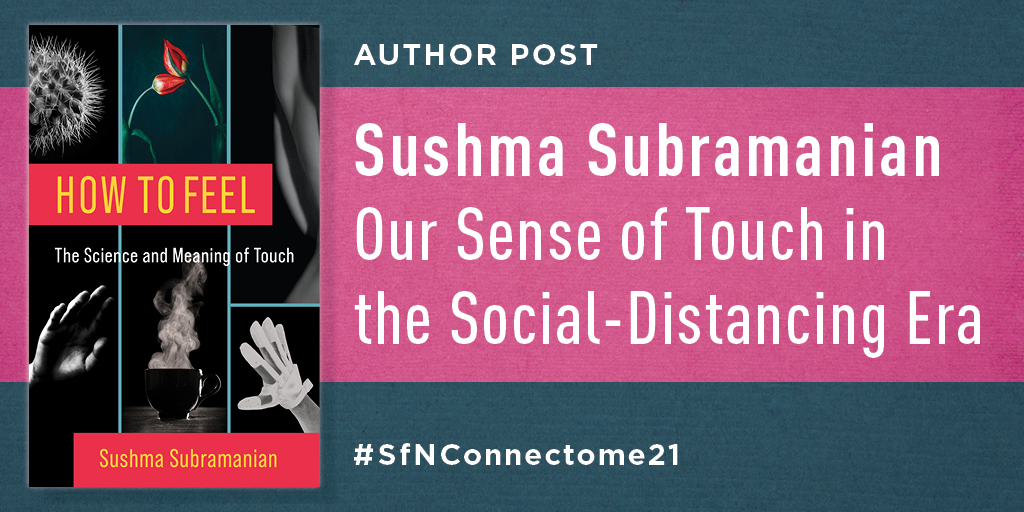Our Sense of Touch in the Social-Distancing Era
By Sushma Subramanian

“In this addictively readable book, Sushma Subramanian explores our vital human sense of touch in terms of history, science, culture, family and most of all humanity. It’s a story full of insight and surprise, told by a science writer with a poet’s sense of language. Don’t miss it.”
—Deborah Blum, Pulitzer Prize-winning author of The Poisoner’s Handbook and Love at Goon Park: Harry Harlow and the Science of Affection
Today’s SFN featured title is How to Feel: The Science and Meaning of Touch, by Sushma Subramanian, which explores the scientific, physical, emotional, and cultural aspects of touch, reconnecting us to what is arguably our most important sense. In this post, Subramanian compares the response to the great plagues of the Middle Ages to our response to the Covid-19 pandemic.
• • • • • •
The great plagues of the Middle Ages had a huge effect on every aspect of people’s tactile lives. Historical records show that traditional religious practices that involved kissing fellow parishioners and holding relics were no longer considered sanitary and were replaced by new traditions that involved kissing devotional images and reflecting on spirituality mentally instead of through direct contact. Conspicuous touching of people and objects in public was viewed with suspicion. Rather than exchanging money directly with people, shopkeepers had customers place it in a pot full of vinegar and avoided handling certain goods.
It’s no accident that as a result of the sense of danger associated with touch, in the late Middle Ages and into the Enlightenment there was an increased focus on visual culture, according to Constance Classen in her book The Deepest Sense: A Cultural History of Touch. Examples include scientific advances such as the microscope and telescope, written expressions of love to replace somewhat risky physical gestures, a new aesthetic preference for grand, expansive views instead of cloistered walled cities, and the rise in popularity of portraiture.
Conspicuous touching of people and objects in public was viewed with suspicion.
This history is relevant today as we think about what our relationship with our senses will be like once we emerge following the Covid-19 pandemic. In some ways, we have become more visual. We use Zoom to attend weddings, funerals, conferences, parties, and work. We order groceries and restaurant meals through apps. But in other surprising ways, we have actually become more touch friendly. Some families have gotten closer as they’ve been stuck in each other’s physical proximity. More people have embraced hobbies such as cooking, dancing, and exercising, and have generally slowed down.
It’s worth thinking about which aspects of this new lifestyle we want to continue and which we want to lose. Perhaps we’ll decide there should be an in-person option for conferences in addition to a remote version. Maybe we will continue to engage in physical hobbies and hug our families more often. Maybe we’ll all go for massages as a part of a healthy routine. When we’re back out in public, we may notice more what we gain from our nearness to other people. We have a chance to examine how it actually feels and how we can best use it to our advantage, even though it’s unlikely we’ll be shaking their hands.
This history is relevant today as we think about what our relationship with our senses will be like once we emerge following the Covid-19 pandemic.
For centuries, we’ve been on one long trajectory toward a vision-centered culture at the expense of feeling. Even before the pandemic, we knew it was making us feel anxious and less connected to each other and to reality in general. Scientific research shows that feeling physical pleasure increases our sense of self and that we actually lose our connection to our bodies the more time we spend on screens. We can now make conscious decisions about whether this is something we continue or there’s a way to redesign our human experience to better appreciate what it means to live in a body wrapped up in a sensitive skin.
Save 20 percent on our conference titles on display when you use coupon code SFN at checkout from our website by March1, 2021.







